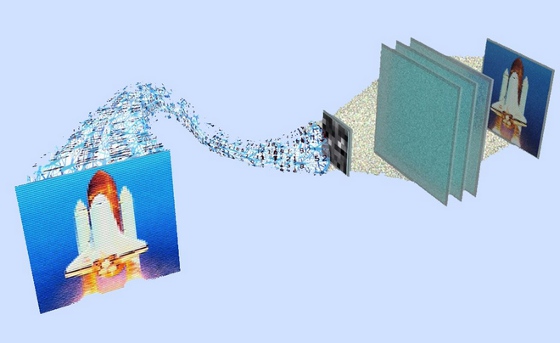 |
| December 20, 2022 | Volume 18 Issue 47 |
Designfax weekly eMagazine
Archives
Partners
Manufacturing Center
Product Spotlight
Modern Applications News
Metalworking Ideas For
Today's Job Shops
Tooling and Production
Strategies for large
metalworking plants
New compression tech and 3D-printed encoder could enable super-resolution displays

A new system uses an algorithm that encodes a higher-resolution image to a lower-resolution one, and then translates the compressed image back to its original resolution by a decoder that unscrambles incoming light. [Credit: Ozcan Lab/UCLA]
A University of California, Los Angeles (UCLA) team has developed a technology for projecting very high-resolution computer-generated images using one-sixteenth the number of pixels contained in their source images. A paper on the development was published in the journal Science Advances on Dec. 2, 2022.
The system compresses images based on an artificial intelligence algorithm, and it then decodes them using an optical decoder -- a thin, translucent sheet of plastic produced using a 3D printer -- that is designed to interact with light in a specific way as part of the same algorithm. The decoder (which currently operates in the terahertz spectrum) consumes no power, which could result in very high-resolution displays that use less power and require less data than current display technologies.
Projecting super-resolution images and 3D holograms requires so many pixels that the task is challenging for -- and in many cased beyond -- the capabilities of current consumer technology. The ability to compress image data and instantly decode compressed images using a thin, transparent material that does not consume power, as demonstrated in the study, could help overcome that barrier and result in technology that produces higher-quality images while using less power and storage than today's consumer technology, even for wearables.
Just what kind of "higher resolution" is the team talking about? One example stated in the study is an augmented reality/virtual reality (AR/VR) device of the future that requires ~50K x 50K pixels (as compared to the 4K tech used in a standard high-resolution TV today, which is 3,840 x 2,160 pixels or about 8.3 million pixels total).
The system uses an algorithm that encodes a high-resolution image to a lower-resolution one. The result is a pixelated pattern, similar to a QR code, that is unreadable to the human eye. That compressed image is then translated back to its original resolution by a decoder designed to bend and unscramble the incoming light.
Testing the system on images in black, white, and shades of gray, the researchers demonstrated that the technology could effectively project high-resolution images using encoded images with only about 6% of the pixels in the original. The team also tested a similar system that successfully encoded and decoded color images.
The technology could eventually be used for applications like projecting high-resolution holographic images for virtual reality or augmented reality goggles. By encoding images using a fraction of the data contained in the original and decoding them without using electricity, the system could lead to holographic displays that are smaller, less expensive, and have faster refresh rates.
The technology could appear in consumer electronics as soon as five years from now, according to the paper's corresponding author, Aydogan Ozcan, Chancellor's Professor of Electrical Engineering and Bioengineering, Volgenau Professor of Engineering Innovation at the UCLA Samueli School of Engineering and an associate director of the California NanoSystems Institute at UCLA.
Other potential applications include image encryption and medical imaging. The research was funded by the Department of Energy.
Source: California Nanosystems Institute
Published December 2022
Rate this article
View our terms of use and privacy policy
